How To Repair Loose Mortar Between Bricks
How to Repair Mortar Joints
Restore crumbling mortar joints with a chisel, a grinder and a lot of patience
![]() Time
Time
Multiple Days
![]() Complexity
Complexity
Beginner
![]() Cost
Cost
Varies
Introduction
Learn the tools and techniques used for tuckpointing old masonry walls and chimneys. Detect how to restore cracked and worn mortar joints, how to cut out one-time mortar and how to pack new mortar in neatly and cleanly.
Tools Required
Materials Required
- Mortar mix
Repair Mortar Joints
Brick is one of the most prized exteriors for homes because it'due south attractive and easy to maintain. Yet over the years, h2o, ice and seasonal expansion and contraction all attack the solid mass of a brick wall at its nigh elastic (and weakest) betoken: the mortar joints.
Mortar joints deteriorate wherever h2o can soak them—nether windows and walls, around chimneys, behind downspouts, at ground level and at any exposed wall tiptop.
Repairing eroding and cracked mortar joints is chosen pointing, repointing or tuckpointing. Nosotros'll testify you the proper tools and techniques to repair and restore cracked and worn-abroad mortar joints to brand them solid, durable and skilful looking. To keep them that mode for the long run, y'all take to cease h2o from getting into your bricks and foundation.
Repointing brick is tedious, painstaking piece of work that requires few special skills but a lot of patience. Using the steps we show, y'all can wait to repoint about 20 sq. ft. of brick work a day. Nevertheless, if you rush and practice careless work on a highly visible area, the repointing brickwork will stick out like graffiti. Brick is durable; bad results will bother you for a long time! If you don't have repointing brick experience, consider hiring a pro for:
- Larger-scale pointing jobs, such every bit a whole wall that needs repair.
- Chimney and wall repair requiring setting up and moving scaffolding.
- Areas with a lot of loose or missing brick requiring rebuilding walls or corners.
- Color-matching new mortar to existing mortar in highly visible areas.
Read on to learn how to repoint brick.
Projection step-past-step (9)
Footstep i
Employ an Angle Grinder for Larger, Harder Repointing Brick Jobs
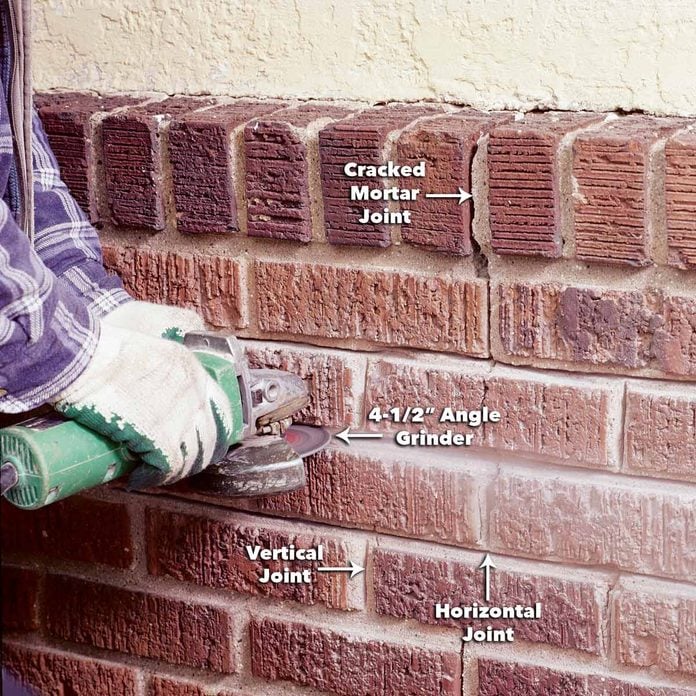
Cleaning out old mortar joints requires basic tools: hammer, flat utility chisel, safety spectacles, dust mask and whisk broom. Filling the cleaned-out joints requires masonry tools: brick trowel, iii/8-in. pointing trowel, a special tool for contouring the joints and waterproof gloves.
If yous do tackle larger jobs or encounter difficult mortar that tin can't be easily chiseled out, nosotros recommend that you lot rent or buy an bending grinder fitted with a diamond bract. Select a grinder with a four-i/2 in. blade diameter; larger grinders are harder to control and cutting the mortar too deep. To begin, Cut grooves 3/iv to 1 in. deep in cracked or deteriorating mortar using a 4-i/2 in. angle grinder fitted with a diamond blade. Push button the bract into the joint until the grinder head contacts the brick, and make a unmarried pass forth the heart of the joints.
Step two
Scrap Out Loose Mortar
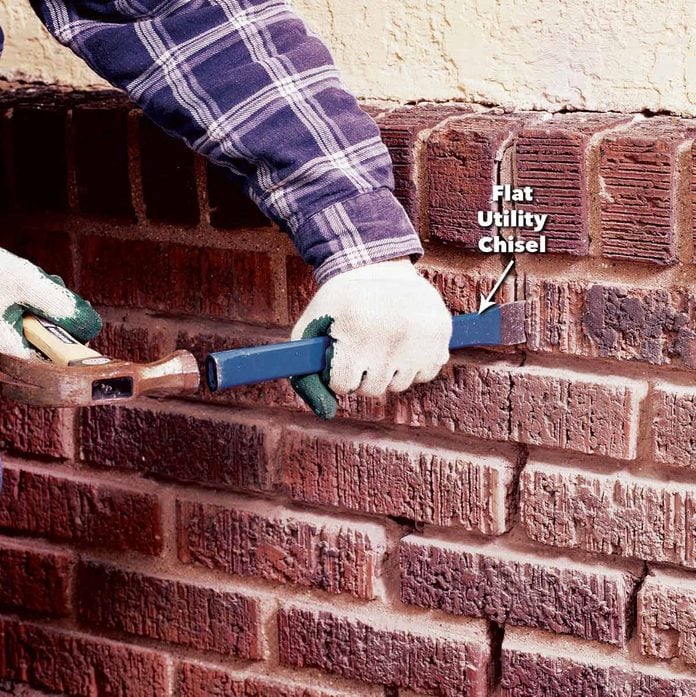
Interruption out sometime mortar using a hammer and cold chisel or a flat utility chisel that's narrow enough to fit into the joints. Position a flat utility chisel at the edge of the brick and drive it toward the relief cut to fracture and remove the mortar. Wear safe glasses and a dust mask and remove 3/4 to i in. of sometime mortar (more than if needed) until you reach a solid base for bonding the new mortar. If the mortar is then soft that the bricks are loosening up, you'll have to remove and properly reset them. If the croaky mortar is harder, make a relief cut downwardly the center of the mortar articulation using the pointed edge of the chisel and so gently scrap out the mortar (brick grout) that contacts the brick.
If the removal work is going really slowly, employ an angle grinder to make the relief cuts. Exercise care here; the grinder can easily nick and flake the bricks, so don't use it to clean out the mortar contacting the brick. To avoid nicking the bricks, cut the vertical joints before cutting the horizontal joints.
Step three
Clean the Joints

Once the one-time mortar is removed, dust out the brick cavity joints using a whisk broom or compressed air, Set the joints to receive new mortar by misting them lightly with a garden hose sprayer.
Step 4
Mix the Mortar
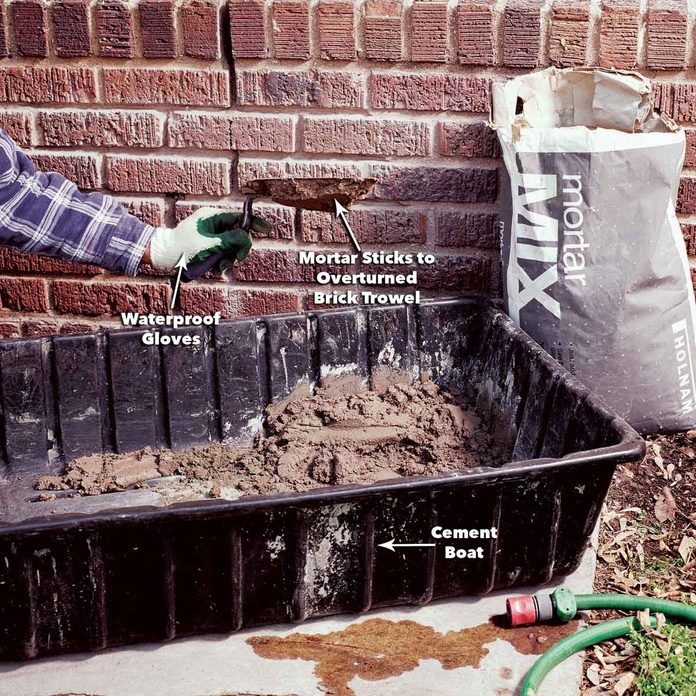
Using only the amount of water specified past the manufacturer, gradually add in the water and mix the mortar in a cement boat until it's the consistency of peanut butter and sticky enough to cling to an overturned trowel. It should be stiff but not crumbly. Allow the mortar to "residuum" for ten minutes as information technology absorbs the water, then remix it using your brick trowel. Don't try to revive mortar that's drying out by adding more water to it. Mix a fresh batch instead.
Step 5
Fill the Joints with Mortar
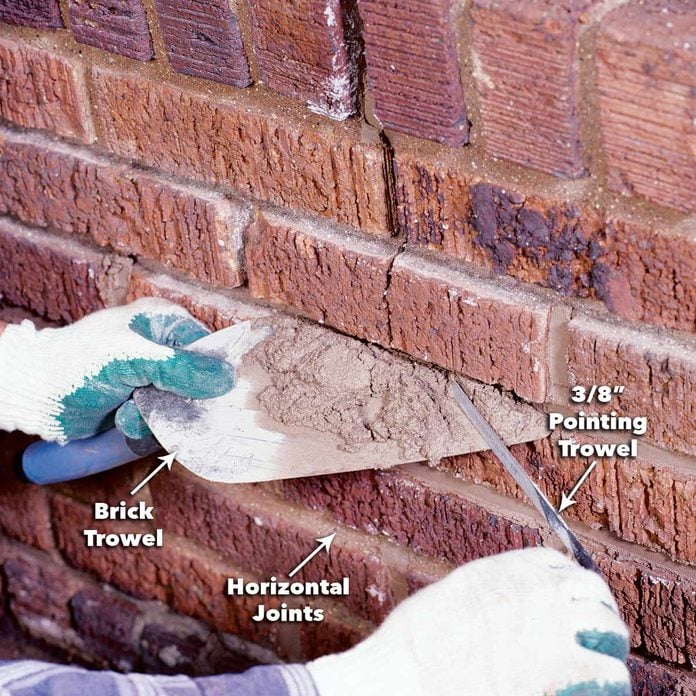
The bones steps for how to mortar brick showtime like this: Load mortar onto an overturned brick trowel, hold the trowel under the horizontal joint—tight to the brick—and sweep 1/four-in. slivers of mortar into the crenel using a 3/8-in. broad pointing trowel. Fill up the horizontal joints first. Avoid getting mortar on the brick face.
Follow these additional tips for filling mortar joints:
- Pack the mortar tightly with no voids for the strongest, about water-resistant joints.
- Fill deeper joints (those greater than 3/4 in.) in two stages. Allow the kickoff layer to partially harden (until a thumbprint barely leaves an indentation) earlier adding the second layer.
- In hot conditions, work in shaded areas first (if possible) then the lord's day won't dry out the mortar too fast. Mix smaller batches of mortar.
- Don't piece of work in temperatures below 40 degrees F.
Stride half dozen
Fill the Vertical Joints Last
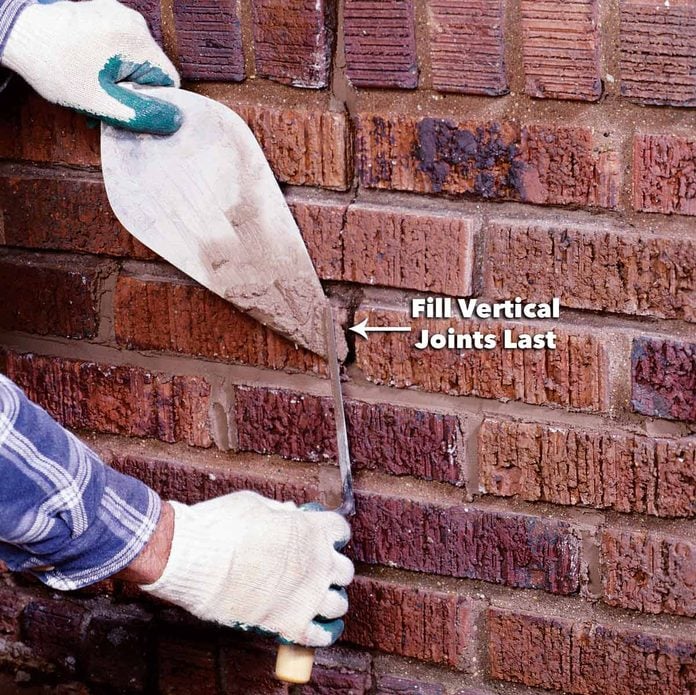
Load smaller amounts of mortar onto the back of the brick trowel, concur the trowel tip along the vertical joints and in a higher place the horizontal joints—tight to the brick—then sweep and pack the mortar into the cavity using the pointing trowel.
Step 7
Figure A: Common Mortar Articulation Profiles
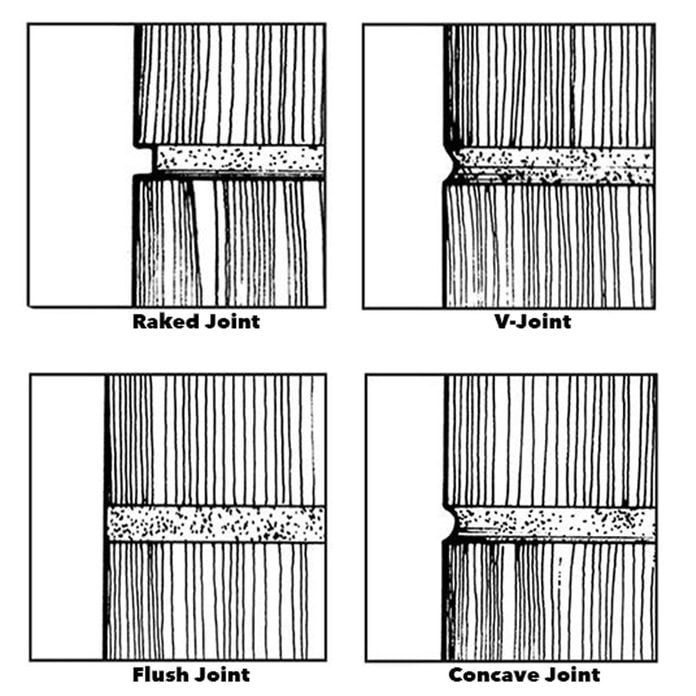
Earlier finishing the mortar joint, make up one's mind which joint matches your existing joints using Figure A above. Next, purchase the mortar finishing tool y'all demand to match the contour and depth of your existing mortar joints. Nosotros recommend that y'all repoint brick sills and other horizontal brick surfaces (ledges, wall tops, etc.) with flush joints to promote drainage—regardless of the type of mortar joint in your vertical walls. Let the mortar to cure to "thumbprint" hardness earlier you finish the articulation. Shape the vertical joints earlier working the long horizontal joints. These are the almost common mortar articulation profiles:
- Raked joint: Formed by removing mortar to one/4 in. deep with a raking cake.
- V-Joint: Formed past a brick jointer, it has a concave, "V" look.
- Flush joint: Formed by cutting off the mortar with the edge of a brick trowel.
- Concave joint: Formed by the curved finish of a brick jointer.
Stride viii
Rake the Joints
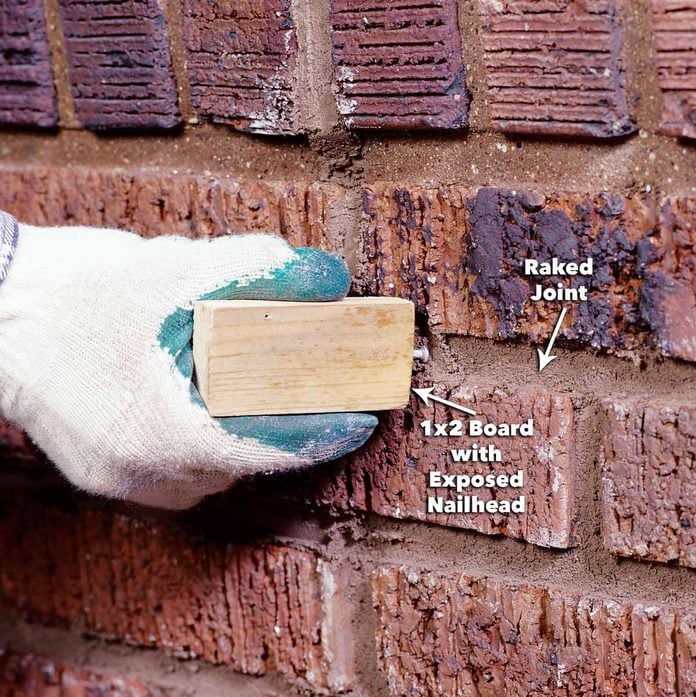
For this project, we used a raked joint mortar profile. To make your ain raked joint tool, drive a 6d box blast into a short 1x2 board so that it matches the depth of the existing joints. To "rake" joints, hold the board perpendicular to the bricks and motility information technology back and forth, first along the vertical joints and then the horizontal joints. Other joint profiles require other shaping tools.
Step 9
Clean the Bricks
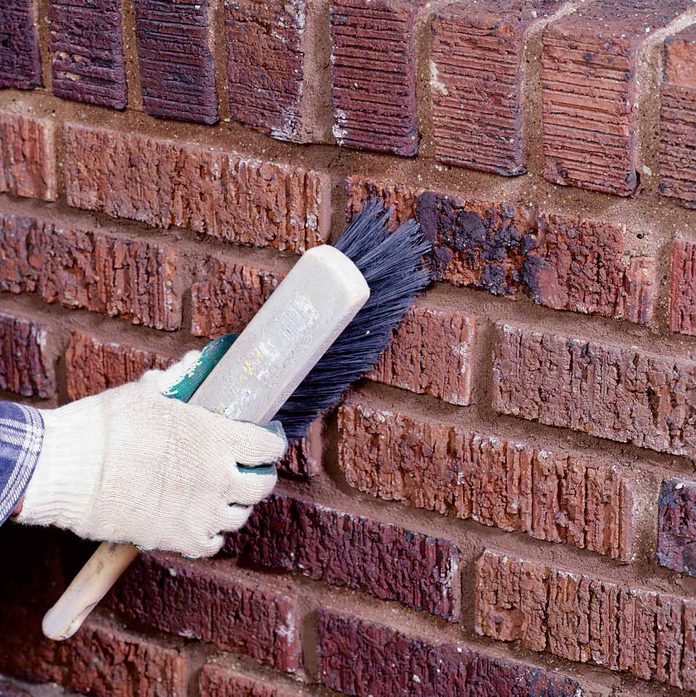
Apply a soft-bristle brush to remove mortar chunks on the brick confront before they harden and to sweep loose mortar from the finished joints. The brush keeps the mortar from smearing. If you practise smear mortar onto the brick, you'll take to go dorsum after and use a chemical cleaner. Prevent water from inbound and damaging your brickwork by applying color-matched polyurethane caulk where stucco, wood and other materials come across brick. Mist the new mortar twice a solar day for ii days using a hand pump sprayer or a lite mist from a garden hose to aid information technology harden.
Plus, check out How to Repair Broken Bricks.
Originally Published: June 26, 2022
Source: https://www.familyhandyman.com/project/how-to-repair-mortar-joints/
Posted by: marlermuscom1994.blogspot.com


0 Response to "How To Repair Loose Mortar Between Bricks"
Post a Comment